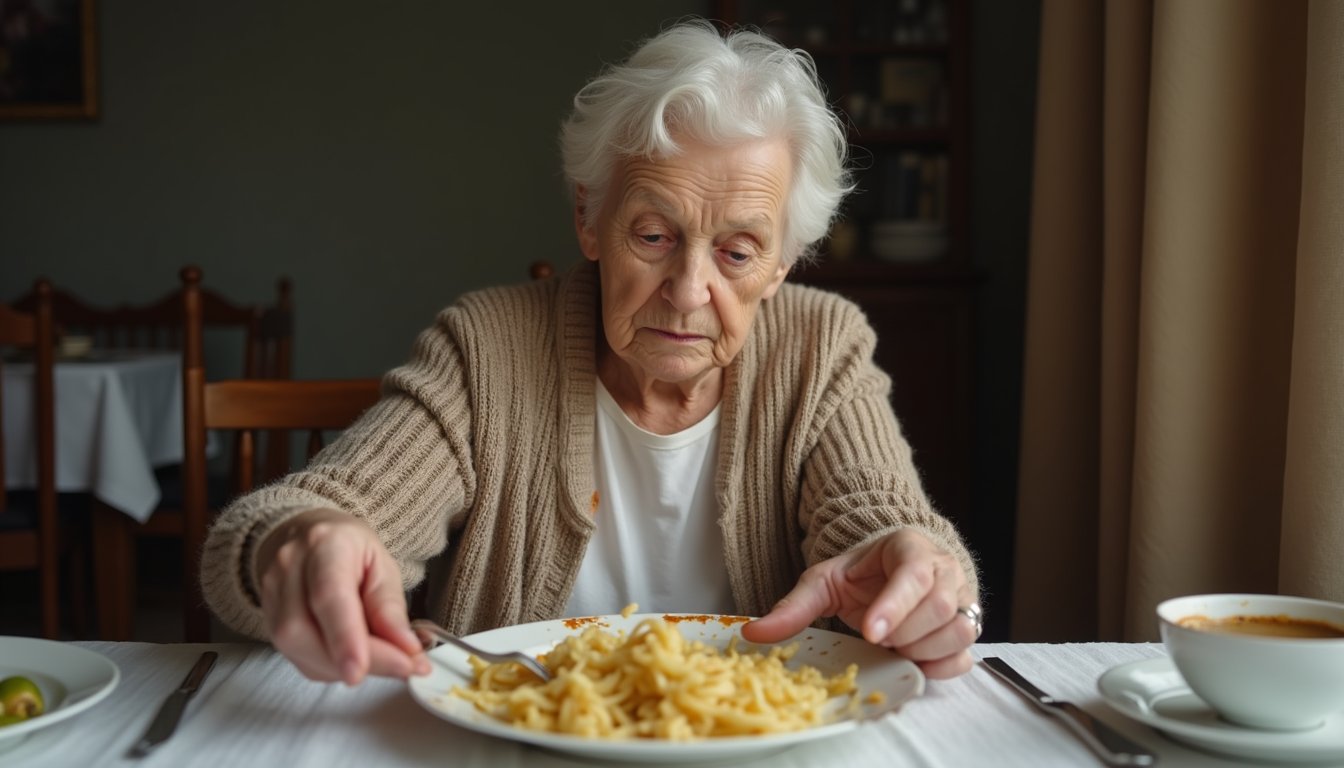Depression symptoms in older adults often look different from those in younger people. You’ll notice more physical complaints like unexplained aches, dizziness, and gastrointestinal issues, rather than emotional distress. Seniors may withdraw from social activities and have trouble expressing feelings, leading to increased irritability. Common signs like appetite loss and fatigue might be mistaken for normal aging. Understanding these age-specific differences can help you identify depression when it’s masked by other symptoms.
Unique Signs of Depression in the Elderly

While depression can affect people of all ages, older adults often experience unique manifestations that differ from younger populations. You’ll notice that elderly individuals may withdraw from social activities they once enjoyed or struggle with sleep patterns, even when opportunities for engagement exist. Their unique coping mechanisms often include self-neglect and reluctance to seek help due to generational stigma. The presence of persistent depressive disorder can manifest as a long-term mood disorder lasting two or more years. Studies indicate that social isolation significantly increases depression risk in the elderly population.
Physical symptoms become more prominent, as chronic illnesses and functional limitations intertwine with emotional distress. You might observe decreased emotional resilience, particularly in those aged 60-69 who are adapting to significant life changes. Watch for signs like underreporting of symptoms, as many older adults normalize their depression as part of aging. Changes in cognitive function and medication side effects can further complicate the recognition of depressive symptoms. Research shows that mental health disorders affect approximately 14% of adults over 60, making early recognition crucial for effective treatment.
Physical vs. Emotional Symptoms
The distinction between physical and emotional symptoms of depression in older adults presents unique diagnostic challenges for healthcare providers. Unlike younger adults who typically express sadness directly, older individuals often manifest depression through physical complaints and emotional numbness. You’ll notice that seniors may report unexplained aches, dizziness, or gastrointestinal issues rather than discussing their feelings of hopelessness or worthlessness. This tendency to focus on physical symptoms can mask the underlying emotional distress, making accurate diagnosis more complex. While physical symptoms like insomnia, weight changes, and fatigue might be attributed to aging or other medical conditions, they’re often interconnected with emotional symptoms. Watch for signs like difficulty expressing feelings, social withdrawal, and increased irritability, as these may indicate underlying depression rather than normal aging. Since depression in older adults frequently coexists with illnesses and disabilities, healthcare providers must carefully evaluate both physical and psychological symptoms to develop effective treatment plans. Understanding that more than 10% of older adults experience depression helps healthcare providers maintain vigilance in screening for both physical and emotional symptoms. Although depression is common among seniors, it’s important to note that most older adults report life satisfaction despite physical challenges.
Key Risk Factors for Late-Life Depression

If you’re experiencing depression in later life, you should know that chronic medical conditions like cardiovascular disease and cancer can greatly worsen your symptoms. Your risk increases considerably when you face major social losses, such as the death of a spouse or reduced contact with family members. Understanding these medical and social risk factors is essential since they create a complex interplay that can make you 1.65 times more likely to experience adverse health outcomes compared to your non-depressed peers. The study found that daily functioning limitations significantly impact depression in older adults. Conditions that affect brain function, including white matter changes, can significantly increase your vulnerability to late-life depression. Older adults commonly experience somatic symptoms more frequently than younger people with depression.
Medical Triggers Worsen Depression
Medical conditions frequently trigger or intensify depression symptoms in older adults, creating a complex interplay between physical and mental health. Comorbid conditions like cardiovascular disease and diabetes greatly increase depression risk, while sensory impacts from vision or hearing loss can lead to social isolation. Neurodegenerative factors, particularly Alzheimer’s and Parkinson’s disease, often coincide with depressive symptoms. Nutritional deficits, especially vitamin B12 deficiency, can significantly contribute to depression in elderly populations. Poor health perception is strongly linked to increased depressive symptoms in older adults.
Your lifestyle choices directly affect depression severity. Smoking, excessive alcohol use, and poor sleep habits can worsen symptoms. Additionally, chronic illness management becomes more challenging when depression is present, as the conditions often share underlying mechanisms. If you’re experiencing physical health changes, it’s essential to monitor your mental well-being, as early intervention can prevent the cycle of worsening symptoms between medical conditions and depression.
Social Loss Heightens Risk
Social losses during later life profoundly impact depression risk in older adults, with bereavement, retirement, and social isolation serving as primary triggers. You’ll find that losing a spouse or child can greatly affect grief processing, with mothers particularly vulnerable after prolonged illness and fathers after suicide. Recent retirees face heightened risk, especially if the change feels forced or sudden.
Your social connections naturally diminish as you age, affecting roughly 25% of older adults. If you’re relocated to a care facility, you’re likely to experience disrupted routines and reduced family visits. Women face greater vulnerability, particularly if they’re widowed or socioeconomically disadvantaged. The combination of reduced autonomy, limited social engagement, and institutional living can intensify feelings of isolation and depression risk.
Why Depression Goes Unnoticed in Seniors
Depression often goes undetected in older adults due to a complex interplay of factors that mask its presence. When misunderstood symptoms like loss of appetite and fatigue are mistakenly attributed to normal aging, critical warning signs get overlooked. Stigma effects further complicate detection, as many seniors deny their depression or avoid discussing mental health concerns due to cultural perceptions and fear of judgment. A staggering 85 and older age group shows the highest rate of suicide among all demographics.
Physical health conditions can obscure depression’s presence, with symptoms often overlapping with chronic illnesses or medication side effects. You’ll find additional barriers in healthcare access, as transportation difficulties and financial constraints prevent many seniors from seeking treatment. The problem extends to care systems, where limited mental health integration and inadequate provider training lead to missed diagnoses. That’s why two-thirds of seniors with mental illness don’t receive the treatment they need. Low-income seniors making less than $25,000 annually face particularly high rates of depression and treatment challenges.
Age-Specific Changes in Depression Patterns

As you age beyond 60, your depression symptoms often shift from primarily emotional manifestations to more physical complaints like fatigue, pain, and sleep disturbances. Your risk peaks between ages 60-69 during major life milestones like retirement, decreases somewhat in your 70s as you adapt to aging, but may increase again after 80 when physical limitations and social losses accumulate. Research shows that social support networks are crucial for preventing loneliness and depression in older adults. Memory difficulties and trouble concentrating are common since cognitive issues frequently accompany depression in seniors. While younger adults typically express depression through mood changes and sadness, you’re more likely to experience depression through somatic symptoms and social withdrawal as you progress through different phases of later life. Despite common misconceptions, depression is not normal when aging and should be evaluated by a medical professional.
Shifting Symptoms Over Decades
While aging brings distinct mental health challenges across different decades of life, depression symptoms manifest uniquely in each age group. You’ll notice shifting perceptions of mental health as you move through your 60s, 70s, and 80s, with evolving symptoms that reflect life changes.
In your 60s, you’re more likely to experience depression due to retirement adjustments and role changes. By your 70s, you’ll typically see lower depression rates as you adapt to aging, though cognitive changes may complicate diagnosis. Once you reach your 80s, depression often resurfaces alongside increased physical limitations and dependency needs. Throughout these decades, your risk factors change, from initial functional limitations to growing social isolation and heightened mortality awareness. These age-specific patterns underscore the importance of recognizing depression’s varying presentations across later life.
Physical Versus Mental Changes
Older adults experiencing depression often exhibit a complex interplay between physical and psychological symptoms that can mask traditional diagnostic markers. You’ll notice physical health complaints like dizziness, aches, and appetite changes frequently overshadow emotional distress in this age group.
| Physical Changes | Mental Changes |
|---|---|
| Somatic pain & fatigue | Reduced emotional expression |
| Sleep disturbances | Memory & concentration issues |
| Mobility decline | Social withdrawal |
While younger adults might readily express sadness, older individuals tend to demonstrate their emotional resilience differently, often through behavioral changes rather than verbal acknowledgment of depression. You’ll find they’re more likely to attribute their symptoms to medical conditions or aging rather than mental health concerns. This presentation can complicate diagnosis, especially when depression co-occurs with chronic health conditions or cognitive changes.
The Impact of Social and Cultural Factors
Depression manifests differently across cultures and social contexts among older adults, with notable variations in how symptoms are expressed, interpreted, and treated. You’ll find that while some cultures emphasize emotional distress, others focus more on physical complaints like headaches, digestive issues, or chronic pain. Cultural stigma often influences whether older adults acknowledge psychological symptoms or seek help.
Social engagement plays an important role in depression among older adults. When you’re isolated due to caregiving responsibilities, bereavement, or functional limitations, you’re at higher risk for developing depressive symptoms. Additionally, ethnic and racial differences affect how symptoms present; African American and South Asian older adults may report more somatic complaints, while White older adults tend to express more psychological distress like hopelessness. These cultural variations greatly impact both diagnosis and treatment approaches.
Treatment Approaches for Older Adults
Treatment of late-life depression requires a thorough, evidence-based approach that combines multiple therapeutic modalities. When seeking care, you’ll find several proven interventions tailored to your needs.
- Psychotherapy options include Cognitive Behavioral Therapy, Problem-Solving Therapy, and Interpersonal Therapy, with each addressing specific aspects of depression.
- Pharmacotherapy adherence remains essential, as antidepressants often form the foundation of treatment, requiring careful monitoring for drug interactions.
- The COMET protocol, when added to usual treatment, specifically targets rumination and enhances overall outcomes.
- Adjunctive therapies like bright light therapy and structured exercise can complement your primary treatment plan.
Your healthcare provider will consider your physical limitations and cognitive status when developing a personalized approach, often combining medication with appropriate psychotherapy for best results.
Frequently Asked Questions
How Long Does Depression Typically Last in Older Adults?
Your depression’s duration factors can vary considerably, typically lasting 6-12 months without treatment. Recovery timeline depends on several variables, including chronic health conditions, social support, and access to mental healthcare. You’ll find that early intervention often shortens episodes, while untreated depression may persist longer. With proper treatment combining medication and therapy, you can expect improvement within 4-6 weeks, though complete recovery may take several months.
Can Retirement Trigger Depression Even if Financially Secure?
Yes, you can experience depression after retirement even with financial stability. The “retirement blues” often stem from non-financial factors like loss of professional identity, reduced social connections, and challenges with emotional adjustment. Research shows that major life changes, including retirement, can trigger depression regardless of your bank account. You’ll face significant alterations in daily structure, purpose, and social networks that require careful psychological adaptation beyond financial planning.
Does Having a Pet Help Prevent Depression in Seniors?
Yes, pet companionship can greatly help prevent depression in your senior years. Research shows that having a pet increases your serotonin and dopamine levels, which directly combat depressive symptoms. You’ll benefit from the emotional support pets provide, leading to reduced loneliness and stress. When you interact with a pet regularly, you’ll experience lower blood pressure, fewer doctor visits, and improved mood. The daily structure and social connections that come with pet ownership further protect against depression.
Are Certain Personality Types More Vulnerable to Late-Life Depression?
Yes, certain personality traits can increase your vulnerability to late-life depression. If you’re more anxious or neurotic, you’ll face a higher risk. You’re also more susceptible if you tend to withdraw socially or have limited support networks. Lower levels of openness and conscientiousness can make you more vulnerable by affecting how you cope with age-related changes. These personality-based vulnerability factors often interact with genetic predispositions to influence depression risk in later life.
How Often Should Family Members Screen Elderly Relatives for Depression?
You should align your screening frequency with professional guidelines while respecting your elderly relative’s privacy. For routine monitoring, conduct informal observations monthly and use validated tools like PHQ-2 quarterly. If your loved one has risk factors (chronic illness, recent loss, isolation), increase family involvement to monthly screenings. Always share screening results with healthcare providers and remember you’re supporting, not diagnosing. Medicare covers annual professional screenings, which you shouldn’t skip.






